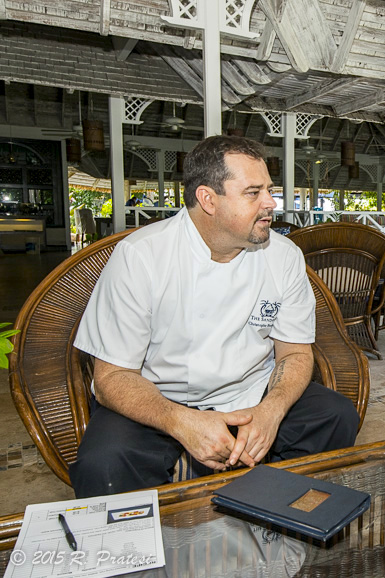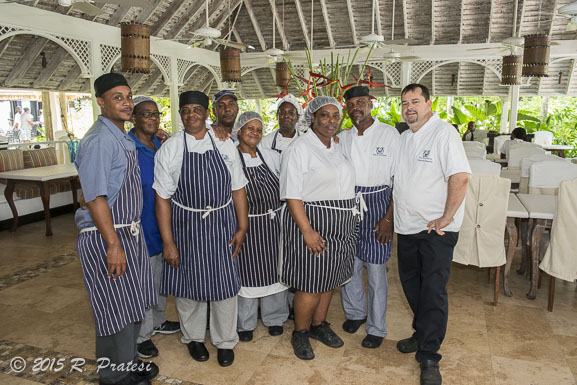A Bajan Specialty – Flying Fish Cou Cou – The Sandpiper, Barbados
With Thanksgiving behind us and winter fast approaching, it’s time to start planning the next tropical escape. Once the first frost has hit and the heat is turned on in the house, I dread the chilly months ahead. This is the time my mind starts daydreaming about those warm Caribbean breezes, a ride on a catamaran, relaxing on white sandy beaches surrounded by sparkling turquoise blue waters, and a rum punch in my hand. This year is no exception.
Last December was our first time to visit the enchanting island of Barbados, where we fell in love with the beauty and charm of the island. It was also where we discovered The Sandpiper, a beautiful boutique luxury resort in St. James (Holetown). Family owned and operated, we appreciate properties like this where there is so much attention to detail and a friendly, knowledgeable, and attentive staff. The Sandpiper has recently reopened after a number of upgrades to the property over the summer months, so we thought it was a perfect time to revisit more of the culture and culinary scene of the Island.
Executive Chef Christophe Poupardin obviously fell in love with this island, too. Born to French parents in Australia, he is a classically trained chef who has lived and traveled throughout Europe, England, and Asia. When he arrived to Barbados in 2002, he settled in and found a home. Defining his cuisine as “European with an Asian twist,” Chef Poupardin has been impressing and feeding repeat customers since arriving at the property thirteen years ago. Many guests (especially Europeans) are also quite smitten with Barbados and The Sandpiper as they return year-after-year for their annual holidays and vacations.
While The Restaurant at The Sandpiper is a top rated spot to dine in St. James, with its beautifully plated dishes, romantic setting, and open-aire dining experience, Chef Poupardin will tell you that the best cooks on the island are the local women, including Michelle, who works at the hotel.
One of the local specialties that both chef and Michelle make is Bajan Flying Fish. There are two versions of this local favorite. One is the elevated version with several plated components and the other a traditional rustic version that is what home cooks on the island will prepare. Bajan Flying Fish is the National Dish that is served on Independence Day (November 30th) on the island and combines cou cou (or cornmeal) with thinly sliced cooked okra and saltfish for seasoning. The cornmeal is cooked together with the okra and saltfish to create a smooth and thickened mixture. This is the base for the dish which is then topped with cooked seasoned fish and a saffron butter sauce and vegetables.
The recipe from Chef Poupardin, Steamed Flying Fish, Saltfish Cou Cou, with Sweet Tomato Chutney, and Saffron Butter, is traditionally prepared with the Bajan Flying Fish. Found in the warm Caribbean waters, the fish is caught with a net, not a rod, and can be found swimming, and flying, around the reefs. They’re very small and they do “fly,” actually skipping and skimming over the surface of the water. They are an iridescent blue color with a white belly and easily blend into the brilliant blue skies and waters of the Caribbean while in mid-air. Mild in taste and flaky, they are difficult to filet because they have quite a few bones.This recipe seasons them well with a local Bajan seasoning mixture (like a sofrito) that will change depending on the cook preparing the dish. However, there are always fresh herbs like thyme, marjoram and perhaps basil, hot peppers, ginger, and onions. The seasoning mixture is spread on the fish filet and then rolled up as a filling before steaming.
Of course, Bajan Flying Fish is not available in our markets in the United States, so good substitutes are Dover sole or lemon sole (which is what I used), or flounder. You want a mild, white, and flaky fish that has been cut into smaller and thin filets.
While there are a few steps to pulling the dish together, most of the components can be prepared ahead of time. I enjoyed creating this Bajan specialty at home, remembering our dining experiences at The Sandpiper, and bringing the flavors of this tropical paradise into our own kitchen.
If your travel plans include a warm getaway this winter, consider a trip to Barbados and The Sandpiper. After one visit, you too may become like many guests, and return year-after-year for your vacation.
*Photo courtesy of The Sandpiper

Flying Fish Cou Cou (Steamed Flying Fish, Saltfish Cou Cou, Sweet Tomato Chutney, Saffron Butter)
This recipe from Chef Christophe Poupardin at The Sandpiper in Barbados is an elevated version of a classic Bajan dish. I’ve modified his original recipe slightly to prepare for a home cook. Be sure to season each component of the dish individually as you prepare the recipe. You will also need to season (to taste) your saffron butter before serving as the amount it requires to finish the dish will depend on the amount of salt added along the way in preparing the other components.
Ingredients:
For saltfish cou cou:
5 ounces saltfish
3 okra, trimmed and finely sliced
4 ounces onion, finely diced
Leaves from one sprig of thyme
5 ounces cornmeal
Kosher salt, to taste
For seasoning mix:
6 oz onions, coarsely chopped
3 each scallion, sliced
1 each garlic clove
1/2 each small jalapeno, seeded and coarsely chopped
1/2 teaspoon Minced fresh ginger
1/2 teaspoon Fresh thyme leaves
1/2 teaspoon fresh marjoram leaves
1 pinch Cloves, ground
1/4 teaspoon salt
1/8 teaspoon freshly ground black pepper
1 1/2 tablespoons red wine vinegar
For tomato fondue:
2 tablespoons olive oil
1 shallot, finely diced
1 clove garlic, crushed
1 28-ounce can whole tomatoes, crushed with hands
2 ½ tablespoons brown sugar, to taste
Kosher salt and freshly ground pepper, to taste
1 tablespoon chopped basil
For flying fish and assembly:
4 small filets Lemon or Dover sole
¼ cup white wine
1 teaspoons saffron, crushed
1 ounce diced red onion
½ cup water
1 stick unsalted butter
Kosher salt and freshly ground black pepper
Directions:
For seasoning mix:
Place everything into a small food processor and pulse until the mixture is finely diced. Remove and place in a container and store covered in the refrigerator until ready to use.
For saltfish cou cou:
1. Soak saltfish in cold water for 4 hours and then rinse and pat dry with paper towels. Cut into small dice. Set aside.
2. Place okra in a small saucepan and cover with water by twice as much, adding a pinch of Kosher salt. Bring to a boil then reduce heat; cook until tender, about 10 minutes. Set aside.
2. Add corn meal to a saucepan with 2 cups cold water and stir while slowly heating. Add in okra and cooking liquid, stirring until most of the liquid is absorbed. Add in salt fish, stir, and then place mixture in a greased 8-inch square glass baking dish. Smooth mixture and allow to cool. Set aside until ready to prepare fish. Cover and refrigerate for longer storage.
For tomato fondue:
1. In a heavy saucepan, heat olive oil until hot, but not smoking. Add in shallot and garlic and sweat over medium heat until softened, about 3 minutes. Add tomatoes with their juice and cook over medium heat until almost all liquid is gone. Add brown sugar and Kosher salt and pepper to taste. Cook until mixture is thick. Add in basil, stir, and set aside.
For flying fish and assembly:
1. Warm tomato fondue and keep on low heat.
2. Slice saltfish cou cou into squares. Add a small amount of canola oil to a skillet and heat until hot, but not smoking. Add the cou cou squares and brown on both sides; remove from pan, set aside and keep warm.
3. Lay the fish filets on a platter and season with salt and pepper; add about 1 tablespoon (or more, depending on size of filets) of seasoning mix to each filet; roll up carefully, securing with a toothpick if necessary.
4. Place white wine, saffron, onion, water, and butter in a tall-sided skillet. Melt butter, stir mixture, and add fish filets. Cover with foil and cook on low for 10 to 15 minutes.
5. To plate, place each fish filet on the saltfish cou cou square and add a little of the saffron butter to the dish. Place a couple of dollops of tomato fondue on the plate and serve immediately.
Executive Chef Christophe Poupardin
The Sandpiper, Barbados, West Indies
This content is protected under International Copyright Laws. Bunkycooks provides this content to its readers for their personal use. No part (text or images) may be copied or reproduced, in whole or in part, without the express written permission of bunkycooks.com. All rights reserved.
















